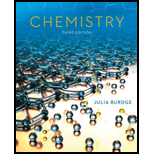
Interpretation:
The standard Gibbs free energy and the equilibrium constant for the given reaction are to be calculated with the formation constant for the reaction.
Concept introduction:
The change in free energy is called Gibb’s free energy and is denoted as
If
The value of
The expression of equilibrium constant
The relation between free energy change and standard free energy change is as:
Here,
At equilibrium the above equation is reduced to the expression:
Answer to Problem 76AP
Solution:
Explanation of Solution
The overall reaction is obtained by adding the two half reactions as follows:
The value of
The expression of equilibrium constant
Substitute
The change in free energy or Gibbs free energy is calculated as follows:
Now, substitute
The standard Gibbs free energy and equilibrium constant for the given reaction are
Want to see more full solutions like this?
Chapter 22 Solutions
Chemistry-Connect Plus Access
- Platinum(II) forms many complexes, among them those with the following ligands. Give the formula and charge of each complex. (a) two ammonia molecules and one oxalate ion (C2O42-) (b) two ammonia molecules, one thiocyanate ion (SCN-), and one bromide ion (c) one ethylenediamine molecule and two nitrite ionsarrow_forwardUse the formation constant of [Au(CN)2] in Appendix K to determine the equilibrium concentration of Au+(aq) in a solution that is 0.0071 M CN and 1.1 104 M [Au(CN)2]. Is it reasonable to conclude that 100% of the gold in solution is present as the [Au(CN)2] complex ion? Explain.arrow_forwardOne of the following nitrogen compounds or ions is not capable of serving as a ligand: NH4+, NH3, NH2. Identify this species, and explain your answer.arrow_forward
- Five-coordinate coordination complexes are known, including [CuCl5]3 and [Ni(CN)5]3. Write the structuralformulas and identify a plausible geometry for thesecomplexes.arrow_forwardThe standard reduction potential for the reaction [Co( H 2 O)6]3+(aq)+e[CO( H 2 O)6]2+(aq) is about 1.8 V. The reduction potential for the reaction [Co( NH 3 )6]3+(aq)+e[Co( NH 3 )6]2+(aq) is +0.1 V. Calculate the cell potentials to show whether the complex ions,. [Co( H 2 O)6]2+ and or [Co( NH 3 )6]2+, can be oxidized to the corresponding Cobalt (III) complex by oxygen.arrow_forwardThe equilibrium constant for the disproportionation copper(I) shown below is 1.81 x 106. If the copper(I) ion is dissolved in dimethylsulfoxide as a solvent the equilibrium constant is only approximately 2. Provide an explanation for the observation.arrow_forward
- H2C2O4.2H2O + K2Cr2O7 → K[Cr(C2O4)2(H2O)2].2H2O What is the role of oxalate ion in this reaction other than being a bidentate ligand?arrow_forwardGive the number of (valence) d electrons associatedwith the central metal ion in each of the following complexes:(a) K3[TiCl6], (b) Na3[Co(NO2)6], (c) [Ru(en)3]Br3,(d) [Mo(EDTA)]ClO4, (e) K3[ReCl6].arrow_forwardWhat is the oxidation number of the central metal ion in each of the following complexes or compounds? [NiCl2F2]2− [Fe(H2O)2(NH3)4]3+ Na[Cu(CN)2] Express the oxidation numbers numerically, in the order that the complexes are listed, separated by commas. For a nonzero oxidation number, be sure to include the sign (e.g., +1,-2,+3).arrow_forward
- Draw the geometrical isomers of complex [Pt(NH3)2Cl2]. (ii) On the basis of crystal field theory, write the electronic configuration for d4 ion if Δ0 < P. (ii) Write the hybridization and magnetic behaviour of the complex [Ni(CO)4].arrow_forwardWhat is the process of making chlorine from the electrolysis of sodium chloride called? chlor-alkali process electrolysis reduction oxidation Which of the following ligands has the weakest field strength? Br- C2O42- NH3 NO2- What common acid will react with silicon dioxide? hydrofluoric acid hydrochloric acid sulfuric acid nitric acid What holds the layers of graphite together? London dispersion forces Hydrogen bonds dipole-dipole forces Ionic bonds Which of the following noble gases can form stable compounds? Xenon Krypton Argon Helium Why are group 12 elements considered representative metals? The last electron is an s electron They do not have d electrons The d electrons move to the s shell none of thesearrow_forwardThe formation constant (Kf) for a coordination complex (Lewis acid–base adduct) is 5 x 10^10. The dissociation constant (Kd) is ... A) 2 x 10^–11 B) 5 x 10^10 C) 1 D) 5 x 10^20arrow_forward
 Chemistry & Chemical ReactivityChemistryISBN:9781337399074Author:John C. Kotz, Paul M. Treichel, John Townsend, David TreichelPublisher:Cengage Learning
Chemistry & Chemical ReactivityChemistryISBN:9781337399074Author:John C. Kotz, Paul M. Treichel, John Townsend, David TreichelPublisher:Cengage Learning Chemistry by OpenStax (2015-05-04)ChemistryISBN:9781938168390Author:Klaus Theopold, Richard H Langley, Paul Flowers, William R. Robinson, Mark BlaserPublisher:OpenStax
Chemistry by OpenStax (2015-05-04)ChemistryISBN:9781938168390Author:Klaus Theopold, Richard H Langley, Paul Flowers, William R. Robinson, Mark BlaserPublisher:OpenStax Chemistry: The Molecular ScienceChemistryISBN:9781285199047Author:John W. Moore, Conrad L. StanitskiPublisher:Cengage Learning
Chemistry: The Molecular ScienceChemistryISBN:9781285199047Author:John W. Moore, Conrad L. StanitskiPublisher:Cengage Learning Chemistry & Chemical ReactivityChemistryISBN:9781133949640Author:John C. Kotz, Paul M. Treichel, John Townsend, David TreichelPublisher:Cengage Learning
Chemistry & Chemical ReactivityChemistryISBN:9781133949640Author:John C. Kotz, Paul M. Treichel, John Townsend, David TreichelPublisher:Cengage Learning





